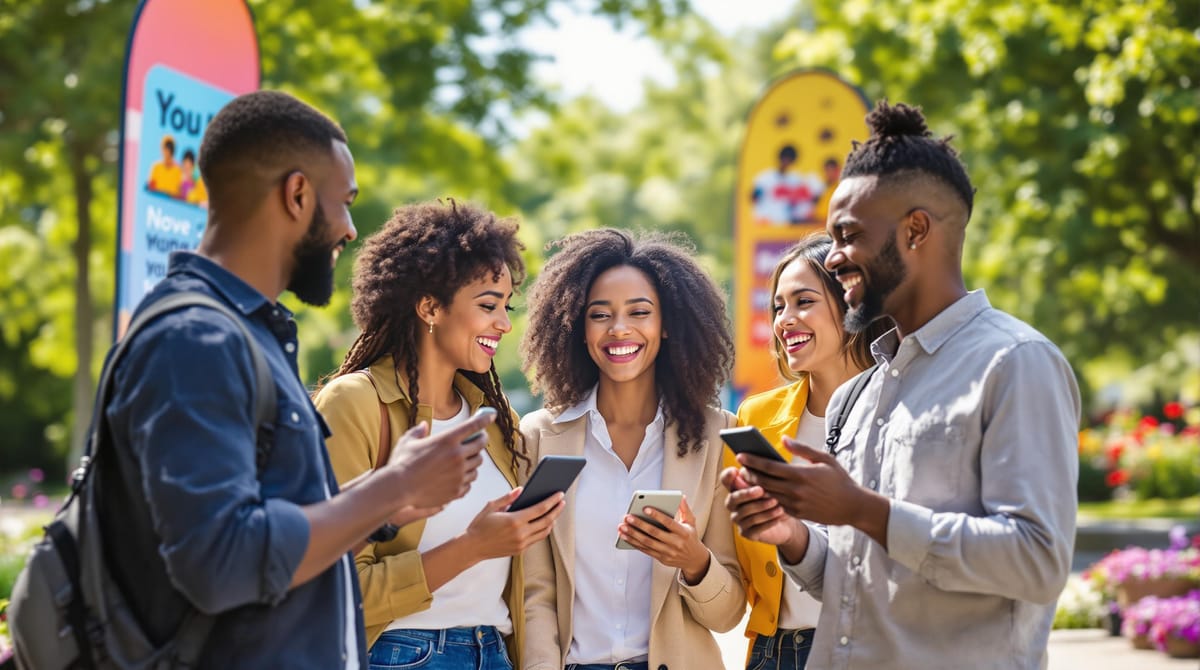Social Media Influencers × Nonprofits: Creating Authentic Partnerships
Explore how nonprofits can authentically partner with social media influencers to enhance engagement, drive donations, and foster long-term relationships.

Social media influencers can help nonprofits reach new audiences, engage supporters, and drive action. 85% of millennials are more likely to donate if an influencer they trust asks them to. Campaigns like the ALS Ice Bucket Challenge raised $115 million, showing the power of these partnerships. To succeed, nonprofits should:
- Choose the right influencers: Look for alignment in values, audience engagement, and authenticity.
- Pick effective platforms: Instagram for visuals, TikTok for viral moments, and YouTube for storytelling.
- Use proven campaign types: Fundraising challenges, ambassador programs, or exclusive behind-the-scenes content.
- Track results: Monitor metrics like engagement, reach, and donations with tools like Google Analytics.
The key? Align the nonprofit’s mission with the influencer’s voice, stay transparent with disclosures, and measure both short-term and long-term impact. Let’s break it down step by step.
Related video from YouTube
Finding the Right Influencers
To choose the right influencers, focus on their audience's engagement and authenticity. Tools like HypeAuditor and Social Blade can help you analyze key metrics, such as:
- Demographics: Understand the age, gender, and location of their followers.
- Engagement rates: Look for consistent interaction on their posts.
- Audience authenticity: Check the percentage of real versus fake followers.
For example, fitness influencer Cassey Ho helped the American Heart Association raise $1.5 million for heart disease research through her workout challenges.
Understanding Audience Data
Start by aligning your goals with the right influencers. This involves filtering candidates based on specific criteria.
Checking Content Alignment
Review their content history to ensure they align with your mission:
- Have they supported similar causes before?
- Is their messaging consistent with your values?
- Do they engage meaningfully with their audience?
- Is their content safe and appropriate for your brand?
Selecting Social Media Platforms
Choose platforms where your target audience is most active. Here's a quick breakdown:
| Platform | Best For |
|---|---|
| Visual storytelling and awareness | |
| TikTok | Viral challenges and quick updates |
| YouTube | Detailed impact stories |
Micro-influencers, those with 1,000–100,000 followers, often achieve higher engagement rates (around 3.86% [7]) because they build stronger connections with their audience.
These steps lay the groundwork for successful partnerships, which we’ll dive into next.
Setting Up Win-Win Partnerships
Building strong partnerships between nonprofits and influencers takes thoughtful planning and clearly defined goals. These collaborations should maintain the trustworthiness discussed earlier while also delivering measurable results.
Types of Campaign Formats
The best partnerships often use a mix of campaign types to achieve maximum impact. Here's how top nonprofits work with influencers:
| Campaign Type | Description | Best For |
|---|---|---|
| Social Takeovers | Influencer runs the nonprofit's social channels | Increasing engagement |
| Ambassador Programs | Ongoing advocacy with regular content | Long-term support |
| Fundraising Challenges | Short campaigns with donation targets | Driving urgency |
| Behind-the-scenes | Exclusive glimpses into nonprofit activities | Building trust |
| Live Broadcasts | Real-time interaction with supporters | Strengthening community |
After selecting the campaign formats, it’s important to agree on compensation models that suit both parties.
Payment and Compensation Options
Nonprofits often need to think outside the box to fairly compensate influencers while staying true to their values:
-
Non-monetary Benefits
These could include special event access or recognition awards. For instance, the National Park Foundation offers influencers unique access to parks through their Find Your Park Expedition program [6]. -
Performance-Based Models
Payments are tied to specific results, such as reaching donation goals, achieving high engagement, or increasing volunteer sign-ups. -
Hybrid Arrangements
A mix of modest fees and mission-driven perks, sometimes supported by corporate sponsors, can balance financial and ethical considerations.
Making Effective Content Together
Creating content that aligns with nonprofit goals while staying true to an influencer’s voice takes careful planning. The collaboration should feel genuine and clearly communicate the cause's message. This phase builds on the partnerships established earlier.
Blending Brand Message with Personal Style
The best nonprofit-influencer collaborations strike a balance between promoting the cause and staying true to the influencer’s voice. For example, this approach has led to a 30% increase in donations and 15,000 new newsletter sign-ups.
Here’s how to combine messaging effectively:
- Provide clear guidelines: Share briefs with key messages, style preferences, and campaign goals, but leave room for creativity.
- Encourage personal stories: Influencers can share their own experiences related to the cause to make the content more relatable.
- Use collaborative reviews: Work together to ensure the content meets the nonprofit’s needs while respecting the influencer’s style.
Staying Transparent with Disclosures
Transparency is essential for building trust and complying with FTC rules. These requirements also align with the ethical standards set during the partnership. All collaborations must include clear disclosures about material connections [4].
Key Disclosure Guidelines:
- Place disclosures at the start of posts.
- Use clear terms like "Ad", "Sponsored", or "Partnership".
- For videos, include verbal disclosures within the first 30 seconds.
- Ensure hashtags like #Ad or #Sponsored are easy to spot and not hidden in a sea of tags.
On platforms like Instagram Stories and Reels, combine platform tools like the "Paid Partnership" tag with manual disclosures. This ensures visibility even if viewers skip through quickly.
To keep audiences engaged while meeting these rules, encourage influencers to share why the nonprofit’s mission resonates with them. Personal storytelling adds credibility and strengthens the campaign’s impact.
Tracking Campaign Results
After working with influencers to create content, it's essential to measure both engagement metrics and donor conversion rates. Keeping an eye on these numbers helps ensure the partnership stays effective and transparent.
Social Media Performance Metrics
Here are some key metrics to track:
| Metric Type | What to Track | Industry Benchmark |
|---|---|---|
| Reach & Visibility | Unique viewers, Impressions | 1-3% follower growth during campaigns |
| Engagement | Likes, Comments, Shares | 3-6% for micro-influencers |
| Content Performance | Video views, Watch time | 1-3% CTR for YouTube |
Pro tip: Use analytics tools specific to each platform to monitor these metrics in real-time. This way, you can make adjustments mid-campaign to improve results.
Donation and Revenue Results
Turning social media engagement into tangible outcomes requires reliable tracking methods. For example, the World Wildlife Fund found that supporters gained through influencers had a 32% higher lifetime value over two years compared to other channels [7].
Effective tracking strategies include:
- Adding UTM-tagged links for each influencer
- Creating unique landing pages to track conversions
- Using CRM systems to map donor journeys
The Nature Conservancy reported a 28% increase in Gen Z donations after a campaign [5]. Insights like these help nonprofits improve their collaborations while staying transparent.
For precise attribution, combine tools like Google Analytics with specialized platforms.
Important: Keep an eye on both immediate campaign results and long-term impact. This aligns with ethical standards and transparency in influencer partnerships.
Best Practices for Long-Term Success
Building and maintaining influencer partnerships isn't just about the launch - it’s about sustaining them with smart, well-planned strategies. Let’s dive into how you can ensure these relationships thrive over time.
Clear Communication Guidelines
Good communication is the backbone of any successful nonprofit-influencer partnership. The American Red Cross sets a great example with their partnership handbook. It lays out everything from content approval steps to reporting and crisis management protocols [1].
To keep communication running smoothly, nonprofits should focus on:
- Defining roles and expectations
- Providing regular updates on campaign progress
- Scheduling feedback sessions
- Ensuring transparent reporting
Pro tip: Use relationship management tools to track interactions and campaign performance. This helps maintain consistent messaging and keeps everyone on the same page.
These steps also align with FTC disclosure requirements, ensuring transparency across the board.
Growing Partnerships Over Time
Strong, long-term partnerships don’t happen overnight - they evolve. For instance, The Nature Conservancy’s "Climate Council" is a standout example. They’ve created an influencer advisory board that collaborates year-round, contributing ideas and content [3]. Similarly, charity: water strengthens bonds by inviting influencers to visit project sites during annual field trips [2].
Here are two ways to grow partnerships effectively:
- Start small: Pilot projects are a great way to build trust before committing to larger initiatives.
- Think long-term: Secure agreements with key influencers to foster deeper connections over time.
Quick note: UNICEF takes a smart approach by rotating partners and themes while keeping their core message intact [4]. This ensures their campaigns stay fresh without losing focus on their mission. It’s a great reminder to prioritize genuine alignment with your cause over short-term, transactional relationships.
Conclusion
This guide has shown how nonprofits can successfully collaborate with influencers by focusing on shared goals, clear communication, and tracking results. With 92% of consumers placing more trust in influencers than traditional ads [8], these partnerships provide nonprofits with an effective way to spread their message while keeping trust intact.
Key points for building strong influencer partnerships include:
- Aligning missions: Choose influencers whose audience and values match your nonprofit's goals.
- Ensuring transparency: Follow FTC guidelines for clear communication and disclosures.
- Fostering long-term relationships: Aim for ongoing collaborations instead of one-time campaigns.
- Measuring success: Track both engagement metrics and the impact on donations.

